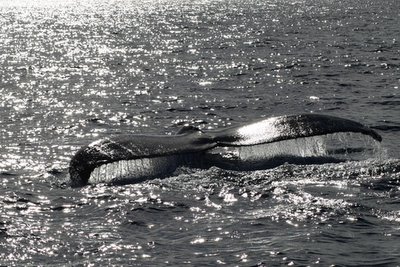Gray Whale-Eschrichtius robustus

GENERAL DESCRIPTION
The gray whale is a baleen whale (it is a filter feeder). Whalers used to call them "devilfish" because of their fierce defense they put up when hunted. They have a layer of blubber up to 10 inches (25 cm) thick. There are hairy bristles (vibrassae) on the gray whale's snout and the front of the head. These are used as tactile sensors, like cat's whiskers.
SIZE
Gray whales grow to be at most 45-50 feet (13.8-15 m) long, weighing about 36 tons (33 tonnes). Females are larger than males, as with all baleen whales.
SKIN, SHAPE AND FINS
The gray whale's skin is usually gray with some blotchy white spots and has many parasites, including hundreds of pounds of barnacles and whale lice. There are little or no parasites on its right side because of the way it scrapes along the ocean bottom to feed.
Gray whales have 2-4 throat grooves, about 5 feet (1.4 m) long each. These grooves allow their throat to expand during the huge intake of water during filter feeding. The gray whale has two broad flippers, no dorsal fin, and a series of small ridges along the its back near the flukes (tail).
DIET AND BALEEN
Gray whales (like all baleen whales) are seasonal feeders and carnivores. They are bottom feeders (benthic feeders). They sieve through the mud on the bottom of the ocean floor of the arctic with their baleen. They filters out small crustaceans (1/2 inch (1.2 cm) long shrimp-like crustaceans called amphipods, krill, copepods, etc.), plankton, and mollusks (including squid and fish) from the ocean sediment. They usually feed on their right side, sucking up mouthfuls of mud filled with organic matter. Their baleen filters out the nourishing organic material (mostly amphipods), and the whale spits out the mud. The tongue loosens the amphipods (and other tiny food) from the baleen plates and the whale swallows the food. During migration and while in the warm breeding waters (about 3-5 months), gray whales eat very little. They live off their thick layer of blubber (fat).
The baleen plates in the gray whale's jaws have about 160 pairs of short, smooth baleen plates. The largest plates are about 15 inches long and 10 inches wide. The baleen bristles are thicker than those of the other baleen whales and are gray with yellowish bristles. The huge, narrow, pink tongue of the gray whale is used to dislodge the food from the baleen, and weighs about 1-1.5 tons (0.9-1.36 tonnes).
MIGRATION
Gray whales make an extraordinarily long migration from the Arctic ocean (northwest of Alaska in the Chukchi Sea) to the Baja peninsula off Mexico, and back each year. They travel about 12,500 miles (20,110 km) each year, staying near the coast. They feed in the cold arctic waters and calve and mate in the warm, protected tropical lagoons of the pacific ocean off Baja, Mexico.
REPRODUCTION
Gray whale breeding occurs mostly in the winter to early spring while near the surface and in warm waters. The gestation period is about 13.5 months and the calf is born head first (unusual for cetaceans) and near the surface of the warm, shallow waters. The newborn instinctively swims to the surface within 10 seconds for its first breath; it is helped by its mother, using her flippers. Within 30 minutes of its birth the baby whale can swim. The newborn calf is about 15 feet long and weighs about 1-1.5 ton. Twins are extremely rare (about 1% of births); there is almost always one calf. The baby is nurtured with its mother's fatty milk (53% fat) and is weaned in about 7-8 months. The mother and calf may stay together for about a year. Calves drink 50-80 pounds of milk each day. Gray whales reach maturity at 8 years. Growth stops at age 40 years old. Mature females give birth every other year in the warm lagoons off Baja, Mexico.
LIFE SPAN
Gray whales have a life expectancy of 50-60 years.
Photography: Sea of Cortez / Cabo San Lucas / Carlos Aboyo

0 Comments:
Post a Comment
<< Home